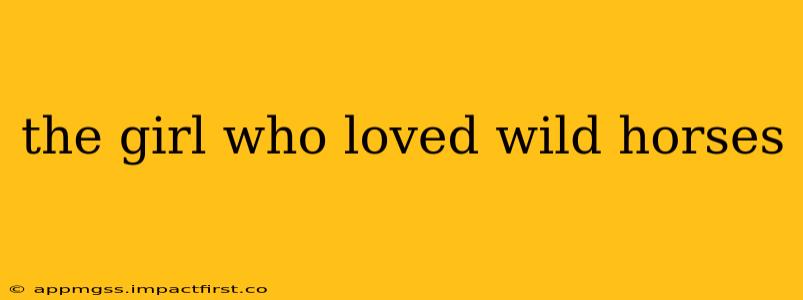The Girl Who Loved Wild Horses: A Deep Dive into the Enduring Allure of Untamed Beauty
The phrase "the girl who loved wild horses" evokes a potent image: a spirit free and untamed, mirroring the majestic creatures she adores. But what is it about these powerful animals that captures the imagination so completely? This exploration delves into the enduring appeal of wild horses, examining the symbolic power they hold and the profound connection humans feel with these magnificent beings. We'll explore the multifaceted reasons why this theme resonates so deeply, considering its presence in literature, art, and popular culture.
Why are wild horses so captivating?
Wild horses, with their untamed spirit and raw beauty, represent freedom, independence, and untamed nature. Their elegance and power are undeniably captivating, drawing viewers into their world of strength and resilience. Their inherent wildness speaks to a yearning within many for a simpler, less controlled existence. The allure isn't simply aesthetic; it's a connection to something primal, a reminder of a time before domestication and confinement.
What is the symbolism of wild horses?
The symbolism of wild horses is rich and multifaceted, varying across cultures and contexts. In many cultures, they represent freedom, power, and untamed spirit. They can also symbolize strength, resilience, and the untamed aspects of human nature. Their connection to the untamed wilderness highlights the beauty and power of the natural world, often contrasting with the manufactured and controlled aspects of human society. This contrast is a powerful symbol of what many seek: a connection to nature and a freedom from societal constraints.
What books and movies feature wild horses prominently?
Numerous books and films have featured wild horses, showcasing their beauty and highlighting the profound connection between humans and these animals. From classic literature to modern-day cinema, the enduring fascination with wild horses continues to inspire creative works. These stories often explore themes of freedom, connection to nature, and the conflict between human civilization and the wild. They often serve as metaphors for human struggles and the search for personal freedom. Specific examples often vary based on the individual's preferences, but many classic stories and contemporary works have incorporated the wild horse theme effectively.
How do people interact with wild horses ethically?
Ethical interaction with wild horses requires a deep understanding of their behavior and habitat. Observing from a respectful distance is crucial. Approaching or interfering with wild horses can cause stress, injury, and disruption to their natural routines. Supporting organizations dedicated to protecting wild horse populations through conservation efforts and responsible advocacy is a vital component of ethical interaction. Learning about and respecting their natural behaviors is paramount in ensuring their survival and well-being.
What are the threats to wild horse populations?
Wild horse populations face numerous threats, including habitat loss due to human encroachment, disease, and the challenges of coexisting with livestock. Predation and harsh environmental conditions also contribute to population fluctuations. These threats highlight the importance of conservation efforts to safeguard these magnificent animals and their vital role in the ecosystem. Understanding these threats allows individuals to make informed decisions about supporting conservation initiatives and responsible land management practices.
How can I help protect wild horses?
Supporting organizations dedicated to wild horse conservation is a powerful way to contribute to their protection. Educating others about the challenges these animals face and promoting responsible land management practices are also important. Advocating for policies that protect wild horse habitats and address the threats they face helps ensure their long-term survival. Even simple actions, like choosing to support brands that align with ethical treatment of animals and wild spaces, can collectively make a considerable difference.
The enduring allure of the "girl who loved wild horses" lies not just in a romantic ideal but in a deeper yearning for connection with untamed nature, freedom, and a powerful symbolism that resonates across cultures and generations. Understanding the rich symbolism and the very real challenges facing these magnificent creatures reinforces the importance of their conservation and the need for continued appreciation of their wild beauty.
